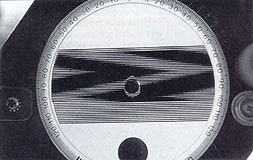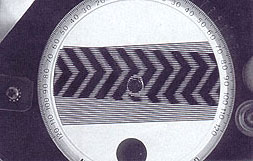|
Readers of my previous article on site survey tools will no doubt remember the review of Data Welder's Satellite Finder. Data Welder is the principal importer and
distributor for the Inogon angle indicator. Their initial application of the tool was in the 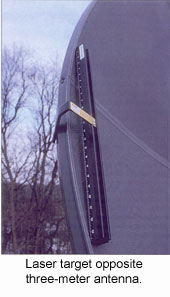 automotive body industry where they combined its measurement accuracy with computer-controlled welding equipment, hence the name Data Welder. The Inogon tool now represents the heart of a
series of alignment tools tailored for satellite industry application by Lennart Naslund, Data Welder's president. automotive body industry where they combined its measurement accuracy with computer-controlled welding equipment, hence the name Data Welder. The Inogon tool now represents the heart of a
series of alignment tools tailored for satellite industry application by Lennart Naslund, Data Welder's president.
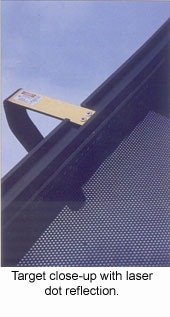 The Inogon tool was introduced over 17 years ago
and is still considered by many to be the best inclinometer available. Its design incorporates two sets of parallel precision etched gratings, allowing accurate measurements to be made
down to 0.2 degrees. The tool functions by allowing one of the etched scales to move as a pendulum disc opposite the other scale fixed in the housing. As the pendulum moves
relative to the angle change, the grating aligns providing an accurate reference. When the lines are out of alignment, a pattern is generated and the number of lines visible allow the
user to interpolate the degree of misalignment based on the arrow patterns visible. The movement of the gratings relative to each other is very smooth due to a clear damping fluid within the tool. The Inogon tool was introduced over 17 years ago
and is still considered by many to be the best inclinometer available. Its design incorporates two sets of parallel precision etched gratings, allowing accurate measurements to be made
down to 0.2 degrees. The tool functions by allowing one of the etched scales to move as a pendulum disc opposite the other scale fixed in the housing. As the pendulum moves
relative to the angle change, the grating aligns providing an accurate reference. When the lines are out of alignment, a pattern is generated and the number of lines visible allow the
user to interpolate the degree of misalignment based on the arrow patterns visible. The movement of the gratings relative to each other is very smooth due to a clear damping fluid within the tool.
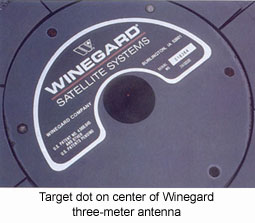 Data Welder has taken a modular approach
to incorporating the Inogon tool into a series of satellite site survey and antenna alignment tools. Once the basic Inogon tool has been purchased, its usefulness can grow with the
purchase of various modules. The tools are designed to speed the site survey and alignment process. The basic Inogon compact inclinometer with magnetic base is small enough
to fit into almost any toolbox or jacket pockets; and, when mounted in the hand held rail assembly with a Silva Precision sighting
compass, it becomes a site and satellite finder. The Silva's glass optics allow heading to be interpolated to 1/2 degree accuracy and Data Welder has affixed a small mirror hinged to the side of the housing. Data Welder has taken a modular approach
to incorporating the Inogon tool into a series of satellite site survey and antenna alignment tools. Once the basic Inogon tool has been purchased, its usefulness can grow with the
purchase of various modules. The tools are designed to speed the site survey and alignment process. The basic Inogon compact inclinometer with magnetic base is small enough
to fit into almost any toolbox or jacket pockets; and, when mounted in the hand held rail assembly with a Silva Precision sighting
compass, it becomes a site and satellite finder. The Silva's glass optics allow heading to be interpolated to 1/2 degree accuracy and Data Welder has affixed a small mirror hinged to the side of the housing.

 |
When not in use, it conveniently folds out of the way again the body of the tool. A nylon adjustment screw rotates the 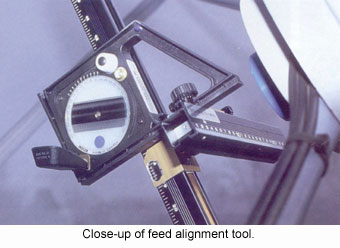 Inogon scale to the desired angle and the unit is positioned until the parallel lines converge. A check of the heading with the Silva compass and you can
evaluate the site for possible obstructions. Should you desire to mount the unit on a tripod, Data Welder can provide one. There is a tapped hole for the standard 1/4-20 thread that camera tripods
utilize. The entire unit comes in a small cordura nylon pouch for convenient storage. Inogon scale to the desired angle and the unit is positioned until the parallel lines converge. A check of the heading with the Silva compass and you can
evaluate the site for possible obstructions. Should you desire to mount the unit on a tripod, Data Welder can provide one. There is a tapped hole for the standard 1/4-20 thread that camera tripods
utilize. The entire unit comes in a small cordura nylon pouch for convenient storage.
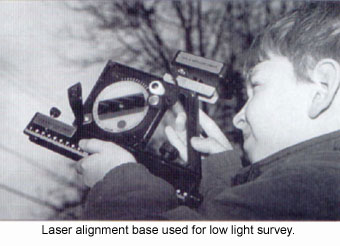 |
The full-sized dish alignment kit contains the Inogon site and satellite finder, a small tripod
as well as extension rails allowing alignment of up to 4.5 meter antennas. The kit arrives packaged neatly within a long arrow padded case which affords a good deal of protection for
your investment. With the extension rails assembled and placed over the 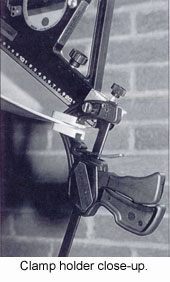 face of the reflector,
the dish's true look angle is accurately measured. The Inogon housing simply snaps in and out of the rail units, allowing you to position it for your convenience. This tool allows DBS
installer to quickly point DIRECTV and other fixed service antennas with a minimum of training. This new "Face Aiming Method," as Data Welder has named it, will provide the
installation crew with an accurate means of initial alignment. Combined with a carrier level meter, the pointing process will only require a couple of minutes providing the mount allows for easy adjustment. face of the reflector,
the dish's true look angle is accurately measured. The Inogon housing simply snaps in and out of the rail units, allowing you to position it for your convenience. This tool allows DBS
installer to quickly point DIRECTV and other fixed service antennas with a minimum of training. This new "Face Aiming Method," as Data Welder has named it, will provide the
installation crew with an accurate means of initial alignment. Combined with a carrier level meter, the pointing process will only require a couple of minutes providing the mount allows for easy adjustment.
 The Inogon tool can be further upgraded with the addition of
the laser base rail unit. Identical in appearance to the standard rail unit, the laser rail has a solid state laser diode aligned with the axis of the base.The laser in activated with a small switch on the
rear of the rail and the tool is now suited to alignment of large antennas with the addition of a reflective target to position on the opposite side of the reflector. The Inogon tool can be further upgraded with the addition of
the laser base rail unit. Identical in appearance to the standard rail unit, the laser rail has a solid state laser diode aligned with the axis of the base.The laser in activated with a small switch on the
rear of the rail and the tool is now suited to alignment of large antennas with the addition of a reflective target to position on the opposite side of the reflector.
Data Welder's information states the tool can be used for alignment of antennas up to 18 meters in diameter. Additionally, the site survey features are
now enhanced for low light use. The laser dot can be seen several hundred feet away as it would reflect off of potential path blockage.
The laser-based tool is also well-suited to verification and adjustment of feedhorn centering.
The base rail incorporates an optical beam splitter that is easily positioned in the path of the laser beam. You now have a tool that can be centered in the face of the dish; and, if the feed
is in alignment, the laser beam will be focused in the center of the dish, as well as the feedhorn throat.
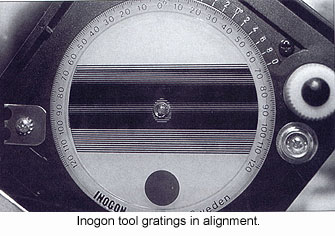 Unlike other feed centering tools on the market, Data
Welder's tool works on offset fed and traditional center fed reflectors. With the Inogon's ability to accurately measure the offset angle, it is a simple matter to position the feed over
the center of the antenna, using the laser beam's dot as a reference, and then dial in the offset angle. The other beam should be centered in the
feed's center. In bright light, the laser dot may be difficult to see, particularly with the beam splitter in use as the laser intensity is reduced. Data Welder has reflective target material to
allow better visibility under these conditions. Unlike other feed centering tools on the market, Data
Welder's tool works on offset fed and traditional center fed reflectors. With the Inogon's ability to accurately measure the offset angle, it is a simple matter to position the feed over
the center of the antenna, using the laser beam's dot as a reference, and then dial in the offset angle. The other beam should be centered in the
feed's center. In bright light, the laser dot may be difficult to see, particularly with the beam splitter in use as the laser intensity is reduced. Data Welder has reflective target material to
allow better visibility under these conditions.
The Inogon tool lends itself to other pointing applications and Data Welder is recommending the DBS alignment tool can also be utilized to aim the local off air antenna
provided it is fixed. With a local map marked to show the television stations transmitter site, the heading from the receive site is easily measured.
For information on the complete Inogon based survey and alignment system, you should contact Lennart Naslund directly at Data Welder.
Gratings in various stages of alignment (clockwise from top left):
Less than 0.5 degrees out, 1 degree, 2 degrees, and 5 degrees out.
by Edgar L. Payne
published, Satellite Retailer
|

 Inogon scale to the desired angle and the unit is positioned until the parallel lines converge. A check of the heading with the Silva compass and you can
evaluate the site for possible obstructions. Should you desire to mount the unit on a tripod, Data Welder can provide one. There is a tapped hole for the standard 1/4-20 thread that camera tripods
utilize. The entire unit comes in a small cordura nylon pouch for convenient storage.
Inogon scale to the desired angle and the unit is positioned until the parallel lines converge. A check of the heading with the Silva compass and you can
evaluate the site for possible obstructions. Should you desire to mount the unit on a tripod, Data Welder can provide one. There is a tapped hole for the standard 1/4-20 thread that camera tripods
utilize. The entire unit comes in a small cordura nylon pouch for convenient storage.

 automotive body industry where they combined its measurement accuracy with computer-controlled welding equipment, hence the name Data Welder. The Inogon tool now represents the heart of a
series of alignment tools tailored for satellite industry application by Lennart Naslund, Data Welder's president.
automotive body industry where they combined its measurement accuracy with computer-controlled welding equipment, hence the name Data Welder. The Inogon tool now represents the heart of a
series of alignment tools tailored for satellite industry application by Lennart Naslund, Data Welder's president.
 The Inogon tool was introduced over 17 years ago
and is still considered by many to be the best inclinometer available. Its design incorporates two sets of parallel precision etched gratings, allowing accurate measurements to be made
down to 0.2 degrees. The tool functions by allowing one of the etched scales to move as a pendulum disc opposite the other scale fixed in the housing. As the pendulum moves
relative to the angle change, the grating aligns providing an accurate reference. When the lines are out of alignment, a pattern is generated and the number of lines visible allow the
user to interpolate the degree of misalignment based on the arrow patterns visible. The movement of the gratings relative to each other is very smooth due to a clear damping fluid within the tool.
The Inogon tool was introduced over 17 years ago
and is still considered by many to be the best inclinometer available. Its design incorporates two sets of parallel precision etched gratings, allowing accurate measurements to be made
down to 0.2 degrees. The tool functions by allowing one of the etched scales to move as a pendulum disc opposite the other scale fixed in the housing. As the pendulum moves
relative to the angle change, the grating aligns providing an accurate reference. When the lines are out of alignment, a pattern is generated and the number of lines visible allow the
user to interpolate the degree of misalignment based on the arrow patterns visible. The movement of the gratings relative to each other is very smooth due to a clear damping fluid within the tool.
 Data Welder has taken a modular approach
to incorporating the Inogon tool into a series of satellite site survey and antenna alignment tools. Once the basic Inogon tool has been purchased, its usefulness can grow with the
purchase of various modules. The tools are designed to speed the site survey and alignment process. The basic Inogon compact inclinometer with magnetic base is small enough
to fit into almost any toolbox or jacket pockets; and, when mounted in the hand held rail assembly with a Silva Precision sighting
compass, it becomes a site and satellite finder. The Silva's glass optics allow heading to be interpolated to 1/2 degree accuracy and Data Welder has affixed a small mirror hinged to the side of the housing.
Data Welder has taken a modular approach
to incorporating the Inogon tool into a series of satellite site survey and antenna alignment tools. Once the basic Inogon tool has been purchased, its usefulness can grow with the
purchase of various modules. The tools are designed to speed the site survey and alignment process. The basic Inogon compact inclinometer with magnetic base is small enough
to fit into almost any toolbox or jacket pockets; and, when mounted in the hand held rail assembly with a Silva Precision sighting
compass, it becomes a site and satellite finder. The Silva's glass optics allow heading to be interpolated to 1/2 degree accuracy and Data Welder has affixed a small mirror hinged to the side of the housing.



 face of the reflector,
the dish's true look angle is accurately measured. The Inogon housing simply snaps in and out of the rail units, allowing you to position it for your convenience. This tool allows DBS
installer to quickly point DIRECTV and other fixed service antennas with a minimum of training. This new "Face Aiming Method," as Data Welder has named it, will provide the
installation crew with an accurate means of initial alignment. Combined with a carrier level meter, the pointing process will only require a couple of minutes providing the mount allows for easy adjustment.
face of the reflector,
the dish's true look angle is accurately measured. The Inogon housing simply snaps in and out of the rail units, allowing you to position it for your convenience. This tool allows DBS
installer to quickly point DIRECTV and other fixed service antennas with a minimum of training. This new "Face Aiming Method," as Data Welder has named it, will provide the
installation crew with an accurate means of initial alignment. Combined with a carrier level meter, the pointing process will only require a couple of minutes providing the mount allows for easy adjustment.
 The Inogon tool can be further upgraded with the addition of
the laser base rail unit. Identical in appearance to the standard rail unit, the laser rail has a solid state laser diode aligned with the axis of the base.The laser in activated with a small switch on the
rear of the rail and the tool is now suited to alignment of large antennas with the addition of a reflective target to position on the opposite side of the reflector.
The Inogon tool can be further upgraded with the addition of
the laser base rail unit. Identical in appearance to the standard rail unit, the laser rail has a solid state laser diode aligned with the axis of the base.The laser in activated with a small switch on the
rear of the rail and the tool is now suited to alignment of large antennas with the addition of a reflective target to position on the opposite side of the reflector.

 Unlike other feed centering tools on the market, Data
Welder's tool works on offset fed and traditional center fed reflectors. With the Inogon's ability to accurately measure the offset angle, it is a simple matter to position the feed over
the center of the antenna, using the laser beam's dot as a reference, and then dial in the offset angle. The other beam should be centered in the
feed's center. In bright light, the laser dot may be difficult to see, particularly with the beam splitter in use as the laser intensity is reduced. Data Welder has reflective target material to
allow better visibility under these conditions.
Unlike other feed centering tools on the market, Data
Welder's tool works on offset fed and traditional center fed reflectors. With the Inogon's ability to accurately measure the offset angle, it is a simple matter to position the feed over
the center of the antenna, using the laser beam's dot as a reference, and then dial in the offset angle. The other beam should be centered in the
feed's center. In bright light, the laser dot may be difficult to see, particularly with the beam splitter in use as the laser intensity is reduced. Data Welder has reflective target material to
allow better visibility under these conditions.
